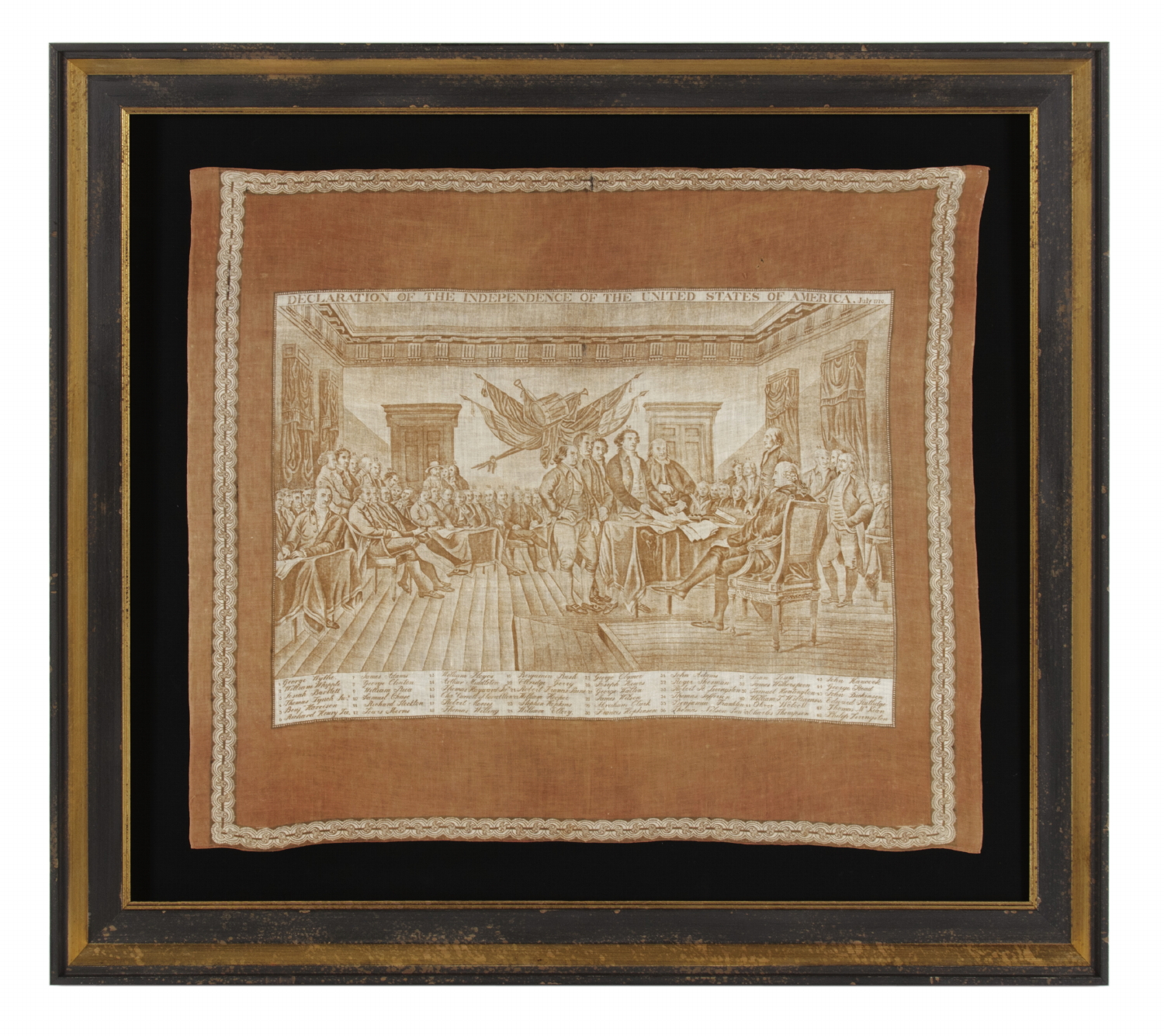
| |
RARE, LARGE SCALE KERCHIEF WITH IMAGE OF JOHN TRUMBULL’S “DECLARATION OF INDEPENDENCE,” MADE FOR THE 1826 SEMICENTENNIAL |
|
| Available: |
Sold |
| Frame Size (H x L): |
40.5" x 44" |
| Flag Size (H x L): |
29" x 33.25" |
|
| Description....: |
|
Printed on cotton, this extraordinarily detailed, large format kerchief pays respect to the Declaration of Independence through its depiction of the famous oil on canvas painting by John Trumbull, George Washington’s aide-de-camp and accomplished painter of historical images. Above the image is the following text: “Declaration of Independence of the United States Of America 4th July 1776,” while below is an accompanying legend that identifies each person by name in a generic script.
Many have mistakenly called Trumbull’s painting “The Signing of the Declaration of Independence”, but what it actually portrays is the presentation of the original draft of the document to the Second Continental Congress on June 28th of that same year. This is why the illustrated men represent only 42 of the 56 who eventually signed the Declaration, while 5 of those present did not sign it at all. The draft was presented by “The Committee of Five”. Led by Thomas Jefferson (Virginia), this group included John Adams (Massachusetts), Benjamin Franklin (Pennsylvania), Robert Livingston (New York), and Roger Sherman (Connecticut). They stand before the table in the center of the illustration.
Trumbull painted many of these men from life and visited Independence Hall in order to get the elements of the interior correct. Trumbull was known for his accuracy of detail, so of notable interest is the rather ironic presence of crossed British flags on the wall in the background. His original painting now hangs in the Yale University Art Gallery, our nation’s first university museum, which Trumbull both designed and furnished (with 88 of his personal works, sold to Yale in 1831 in exchange for a $1,000 annuity). Most of the fame of the painting, however, comes from the 12 x 18 foot copy that was commissioned from Trumbull by Congress in 1817 and placed in the United States Capitol Rotunda in 1826, where it remains today.
An example of the bandanna is pictured in “Threads of History” by Herbert Ridgeway Collins (Smithsonian Press, 1979, p. 200, item 418). Collins formerly served as the Smithsonian's curator of political history and his text is considered the definitive reference on American political textiles. In the text, Collins dates the illustrated kerchief to 1876, under the surmise that it was made in conjunction with the 100-year anniversary of our nation’s independence. This date is certainly incorrect. The kerchief is of very large format when compared to those of the late 19th century. To this end it more closely resembles the kerchiefs made between the last quarter of the 18th century and the 1850’s. The textile has a very early appearance, partly because the illustration was made from a copperplate engraving and partly because the sepia and nut brown ink used within are common in pre-Civil War textiles. In addition, the binding of the top and bottom is hand-sewn with exceptional precision. This is not the case with ca 1876 kerchiefs, which are more likely to be bound with a treadle machine. Since none of these traits point to the late 19th century, the kerchief was not made to celebrate 100 years of American Independence in 1876, but rather 50 years of independence in 1826 (our nation's semicentennial or quinquagenary). This would coincide with the hanging of Trumbull’s painting in the Rotunda and would thus better explain not only its size, coloration and construction, but also its purpose.
Surviving examples of these kerchiefs are extremely rare. The same style exists with a blue border instead of brown. Another style is also known that shows the same image on top, but smaller, with a wider border, and instead of the generic signatures below, it contains a legend of actual signatures and sketched portraits. The illustrated by Collins actually differs slightly from all of the above. Blue in color, the word “Independence” is misspelled on that example as “Independance”.
On the original painting, many have noted that Jefferson’s foot, which is pointed at a somewhat odd angle, is purposely stepping on that of Adams. The two men were political enemies, so it is supposed that this was done on purpose. Close inspection, however, revealed that their shoes were merely close to one-another. Trumbull widened the distance in the Rotunda copy and a clear separation of their feet can be seen in the reproduction of the image on the kerchiefs.
Mounting: The kerchief has been hand-stitched to a background of 100% cotton, black in color, that has been washed to reduce excess dye. An acid-free agent was added to the wash to further set the dye and the fabric was heat-treated for the same purpose. The mount was then placed in a black-painted, hand-gilded and distressed Italian molding. The glazing is U.V. protective Plexiglas.
Condition: There is moderate fading throughout and there are a couple of tiny holes in the brown field above the image. |
|
|
|
| Collector Level: |
Flags for the truest Patriots. My best offerings |
|
| Flag Type: |
|
|
| Star Count: |
|
|
| Earliest Date of Origin: |
1820 |
|
| Latest Date of Origin: |
1826 |
|
| State/Affiliation: |
Pennsylvania |
|
| War Association: |
1777-1860 Pre-Civil War |
|
| Price: |
SOLD |
|
| |
Views: 2388 |
|
|
|

